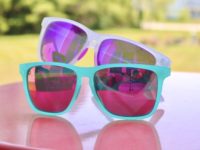Going on a safari is a bucket list vacation for lots of people. Being out on the open savanna with exotic wildlife is an experience you’ll never forget. But this type of safari vacation can be a little more difficult to pack for than, say, a beach vacation. There are very specific things you need when you’re going on a safari so a packing list is essential.
It was really frustrating searching for a good safari packing list before my big trip to Tanzania and Kenya. I either found packing lists that were full of ugly clothes or ones that were utterly ridiculous (a maxi dress and jumpsuit for an African safari?) Get real!!
So, I figured I’d take what I learned doing the research for my trip and write my own guide. This ultimate safari packing list is full of practical tips and great suggestions for what to wear on a safari.
This safari packing list was based on my trip to Tanzania and Kenya, but it will be applicable to most African safaris.

Legal Stuff: This post may contain affiliate links or credit card referral links. We are a participant in the Amazon Services LLC Associates Program, an affiliate advertising program designed to provide a means for us to earn fees by linking to Amazon.com and affiliated sites.
What To Pack For A Safari In Tanzania and Kenya
Booking a safari in Tanzania and Kenya was a huge thrill. An African safari has been at the top of my bucket list for a long time, and I was so excited it was finally happening. There was only one problem — you need to wear muted, neutral colors on safari, and my closet was full of bright and bold colors and patterns (hello, purple leopard print). So, I basically needed to buy an entirely new safari wardrobe. Cue shopping mode!
Here are a couple of things you’ll want to keep in mind when packing for an African safari.
Colors
When going on an African safari, you really need to pay attention to the colors you’re wearing. Khaki, tan, green (olive, not lime), and light browns are recommended.
Don’t wear blue or black clothes because these colors can attract the tsetse flies. Don’t wear white because it gets dirty very quickly. Don’t wear bright colors because you’ll stand out on the savanna (and you want to blend in with the natural surroundings as much as possible on a safari.
Colors to wear on safari: Khaki, tan, olive greens, browns
Colors to avoid on safari: White, black, blue, and any bright colors
Patterns
Don’t wear bold prints and patterns on safari, including leopard print (damn, there goes half of my wardrobe) and camo. In some African countries, camo prints are reserved for the military only — it’s actually illegal in some countries — so avoid it while you’re traveling through Africa.
Fabrics
You’ll want moisture-wicking, fast-drying, and UV-protective clothing while on safari.
Accessories
While you’ll want to keep jewelry to a minimum, there are a few other accessories you’ll need. You can’t go on safari without a good safari hat. I’d also recommend a small belt bag to keep essentials like your passport close by at all times. Sunglasses are also essential.
Best Card for Everyday Purchases: Earn 2 points per $1 on ALL purchases with the Capital One Venture X Rewards Credit Card
Safari Clothes
A safari is a trip where you’ll need to focus more on function than fashion (and it kills this former fashion designer to say that). Opt for performance-type fabrics that provide UV protection, breathability, and moisture-wicking. You’ll most likely be wearing outfits more than once, so avoid fabrics like cotton that hold on to odors easily.

What I Wore on Safari [Women’s Safari Clothes]
I loved this button-up shirt from REI in Olive. The lightweight fabric was moisture-wicking and quick-drying. Plus, the adjustable sleeves provided lots of flexibility. This version from Amazon is similar and available in
For layering, I wore this Renew Racerback Tank from Athleta in Ballerina Gown.
The Momentum Top in Bali Green, also from Athleta, was a great long-sleeve option.
For a short-sleeved option, I went with the In Motion Tee in Olive Green from Athleta. This UPF 50+ quick-dry option from Amazon would also work well.
My choice for safari pants was the Halle Straight pants from Prana in Slate Green. They were comfortable and held up to lots of wear and tear on my 2-week trip.

For a light jacket, I chose The North Face Mountain Sweatshirt Hoodie in Agave Green. It was lightweight yet kept me warm enough about 98% of the time. It can get chilly in the mornings and evenings on safari, so I ended up wearing this every day, and it held up great.
I also had this travel vest from SCOTTeVEST with lots of pockets. It was a great alternative on days when I didn’t want to carry around a separate bag.
My husband and I ended up getting the same safari hat. It was adjustable and had a chin strap (which came in very handy). Plus, you could squish it down flat to pack.
I wore hiking shoes from Merrell. The exact style I wore isn’t available anymore, but they were similar to these. My shoes were very comfortable and stood up to the 2-week trip with ease.

Men’s Safari Clothes
In case you’re looking for men’s safari clothes, here’s a rundown of what my husband wore on safari.
- Merrel Moab 2 Waterproof Hiking Shoes
- Sunday Afternoon Charter Escape Hat
- The North Face Echo Rock Pullover Hoodie (It’s sold out now, but this would be a good alternative)
- ExOfficio BugsAway Monto UPF 50 Long Sleeve Shirt (No Longer Available)
- Arc’teryx Short Sleeve Shirt (there’s also a great long-sleeved version available)
- Patagonia Capilene Cool Trail Shirt (This is sold out now, but here’s a similar alternative)
- Columbia Silver Ridge Convertible Pants
The Ultimate Safari Packing List – Tanzania and Kenya
A safari isn’t something you can quickly pack for the night before you leave. It will take a little bit of planning and probably a few purchases since you may need to buy safari-specific clothing and essentials.
Here’s what you’ll need for an African Safari:
Travel Documents and Money
- Valid passport
- Yellow fever vaccination records/certificate
- Visas
- Copy of flight itinerary
- Personal medical/dental insurance cards
- Cash in U.S. Dollars (bills MUST have been issued in 2004 or later). Divide your cash into different areas of your carry-on luggage, wallet, and money belt just in case something happens to one of those items.
- Travel insurance information (While I usually rely on the travel insurance offered by my credit card, I did purchase a separate policy for this trip.)
- Credit card without a foreign transaction fee. Here are 2 of my favorites:
Capital One Venture X Rewards Credit Card – Earn 75,000 bonus miles (worth $750+)
Chase Sapphire Reserve® – Earn 60,000 bonus points (worth $900!)


Clothing
- Sweater or fleece pullover to keep warm
- Sturdy boots or shoes
- Sun hat
- Sunglasses
- Moisture-wicking T-shirts (2 to 5, depending on how often you want to change)
- Tank tops (2-3 for layering)
- Long sleeve shirts (1 or 2)
- Shorts (1 pair)
- Long trousers (2 to 3 pairs)
- Vest with pockets
- Underwear/Socks/Bras (bring long socks to keep your ankles covered)
- Sleepwear
- Flip Flops (for tented camps and lodges)
- Bathing Suit (optional)
Essentials
- Camera and memory cards (this is the camera that I used)
- Telephoto lens for your camera (don’t skip this…your pictures will be significantly better with a good lens)
- Binoculars
- Sunscreen
- Lip balm with sunscreen
- Hand sanitizer and wet wipes
- Insect Repellent
- Personal toiletries (soap, shampoo, toothbrush, deodorant, eye drops, etc.)
- Travel towel (depending on the type of accommodations you will be staying at)
- Malaria tablets
- Basic first aid kit
- Prescription medicines (plus extra)
- Extra pair of prescription glasses/ extra contacts
- Flashlight or headlamp
- Chargers and extra batteries for your camera, phone, etc
- Power adapter that fits UK-style electrical sockets
- Travel-sized laundry detergent for handwashing
- Tylenol, Benedryl, and any other OTC medications that you take occasionally
Extras
- Small notebook or journal to record your adventures
- African animal guide book
- Kindle
- iPad
Luggage
Bring soft luggage such as a duffel bag, hiking pack, or sports bag. These are ideal for packing into a safari vehicle. Hard suitcases can often be difficult to fit into safari jeeps. Look for something durable yet inexpensive…you don’t want to worry about your bag when it gets squished in the back of a safari vehicle.
Bring a backpack to carry all of your important items, including travel documents, money, camera, medication, etc. You should keep this backpack with you at all times.
Don’t forget to leave space in your luggage for the all-important souvenirs you will probably buy. It’s not a bad idea to bring along a packable tote that you can use if you can’t get everything back into your bags on the way home.
Final Thoughts
Going on an African safari was a trip of a lifetime for me. While I thoroughly enjoyed my trip, it did take more planning effort than other trips I’ve been on, including buying a lot of new clothes suitable for safari. I hope my safari packing list helped you out and made packing for your safari a breeze!

![You are currently viewing Safari Packing List [Tanzania and Kenya]](https://www.zenlifeandtravel.com/wp-content/uploads/2021/11/What-to-wear-on-safari.jpg)


